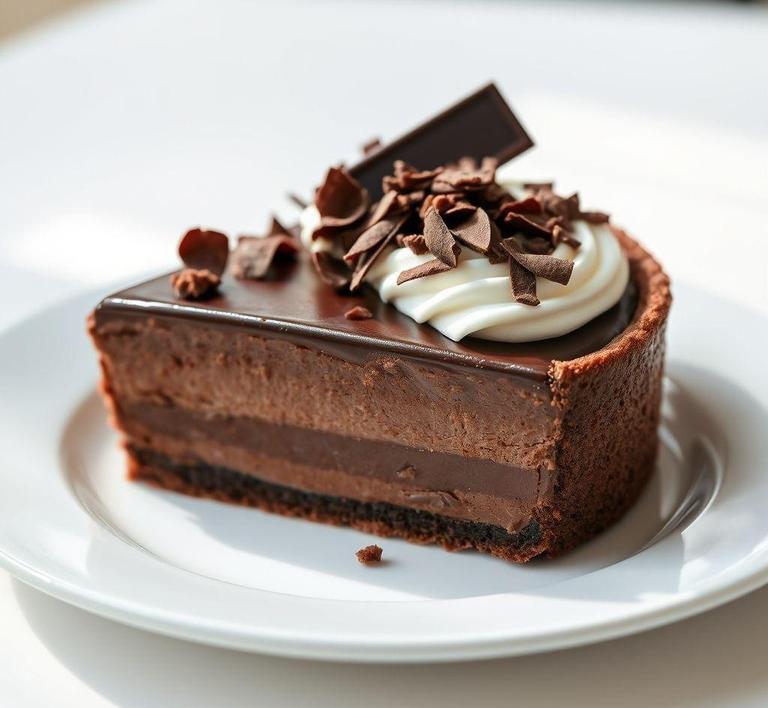If you’ve ever made a decadent chocolate cream pie and found yourself with leftovers (lucky you!), you might be wondering how to store it for later enjoyment. Refreezing chocolate cream pie is a great way to extend its shelf life while keeping that rich, creamy texture intact. But, of course, it’s important to follow a few simple steps to ensure your pie stays as delicious as the day you made it. Whether you’re prepping for a special occasion or just love the idea of pie whenever you want it, this guide will walk you through the best way to refreeze and store your chocolate cream pie without compromising its flavor or consistency.
Can You Refreeze Chocolate Cream Pie?

The short answer is yes, you can refreeze chocolate cream pie, but whether you should or not depends on a few key factors. To understand why, it’s important to know what happens to the pie when it’s frozen, thawed, and refrozen. Chocolate cream pie, with its delicate, creamy filling and flaky crust, is a dessert that can indeed be frozen and refrozen, though it may not always retain its original texture and flavor.
When you freeze chocolate cream pie, the filling-typically made from rich ingredients like chocolate, cream, eggs, and sugar-becomes firm. The crust, depending on the type used, can sometimes become soggy after thawing due to the moisture released by the filling. If you refreeze the pie, the moisture trapped inside the filling and crust may alter the texture even further, potentially leading to a less desirable final product.
The important point to consider when deciding whether to refreeze chocolate cream pie is whether it has been properly stored and handled during the initial thawing process. If the pie was thawed slowly in the refrigerator and hasn’t been left out at room temperature for too long, then refreezing is generally safe. However, if it was thawed at room temperature or exposed to fluctuating temperatures, bacteria can grow, which can affect both the safety and taste of the pie.
How To Refreeze Chocolate Cream Pie?
If you decide to go ahead and refreeze your chocolate cream pie, following the right process is essential to maintain as much of its quality and taste as possible. Here’s a step-by-step guide:
-
Check the Pie’s Condition:
Before refreezing, check how the pie was thawed. If it was left out at room temperature for more than two hours, it might not be safe to refreeze. If it was properly thawed in the fridge and still looks and smells good, you’re on the right track.
-
Wrap the Pie Securely:
You need to protect the pie from freezer burn and preserve its moisture. Wrap the pie tightly in plastic wrap or aluminum foil. Be sure to cover all the edges to avoid exposure to air. If your pie is in a pie dish, you can also place it inside a large resealable freezer bag for extra protection.
-
Label the Pie:
Use a permanent marker to label the pie with the date it was frozen. This helps keep track of how long it has been stored, as the quality of the pie will decrease over time, even in the freezer.
-
Freeze it Quickly:
Once wrapped, place the pie in the coldest part of the freezer to freeze it as quickly as possible. This helps to lock in the texture of the filling and minimize any crystallization that could affect its texture later.
-
Thawing When Ready to Serve:
When you’re ready to enjoy your refrozen chocolate cream pie, it’s important to thaw it slowly in the refrigerator, preferably overnight. This ensures that the filling doesn’t become too watery or lose its creamy texture. Avoid thawing it at room temperature to prevent any moisture separation or bacterial growth.
Quality Impact
While refreezing chocolate cream pie is possible, it does affect its quality in several ways. Here’s a breakdown of what happens:
-
Texture Changes:
One of the most noticeable effects of refreezing chocolate cream pie is the texture. The crust, especially if it’s a traditional pie crust, may not hold up as well after being frozen and thawed multiple times. Freezing causes water inside the filling to form ice crystals. When the pie thaws, those ice crystals melt, sometimes leading to a soggy or mushy crust. Refreezing will likely exacerbate this issue, leaving you with a pie that might be less crisp and flaky than when freshly made.
-
Filling Consistency:
The creamy filling of a chocolate cream pie, made from chocolate, eggs, cream, and sugar, is susceptible to changes in texture when frozen and thawed. Initially, it may set nicely, but with repeated freezing and thawing, the mixture can separate slightly, or become grainy, especially if the chocolate filling contains milk or heavy cream. The pie filling could lose its smoothness, and the velvety texture may become more runny or watery.
-
Flavor Alteration:
While the flavor of chocolate cream pie should largely remain intact after freezing and refreezing, small changes can occur. Freezing can dull the richness of the chocolate flavor, making it seem less intense or fresh. The sugar content may also slightly alter, and the pie might lose some of the original sweetness and creaminess. Additionally, depending on the length of time the pie is frozen, it could develop subtle off-flavors from freezer burn, though proper wrapping can help minimize this.
-
Bacterial Growth:
One of the biggest concerns with refreezing a dessert like chocolate cream pie is the potential for bacteria growth. When you thaw the pie, especially if it’s done at room temperature, the filling may move through a temperature range that encourages bacterial growth. Refreezing will not kill bacteria, so it’s crucial to ensure that the pie is properly stored and thawed in a controlled environment (i.e., the refrigerator) to prevent any food safety issues.
Refreezing chocolate cream pie is technically possible, but it comes with some caveats. The most significant quality issues arise in terms of texture and flavor, as the crust may lose its crispness, and the filling can become watery or grainy. However, if the pie has been stored and thawed correctly-slowly and at the right temperature-refreezing it won’t pose a serious safety concern, though it may affect the final result.
If you’re planning to serve chocolate cream pie again after freezing and refreezing, consider whether the slight sacrifice in texture and flavor is worth it. For the best experience, it’s always recommended to consume a freshly thawed pie, ideally after a single freeze cycle. But if you find yourself with extra pie and a need to preserve it for later, following the proper freezing and thawing steps will help maintain the best possible quality.
While refreezing chocolate cream pie is feasible, it’s a balance between convenience and maintaining the pie’s original excellence. If possible, it’s better to freeze individual slices or consume the pie within a reasonable time frame to avoid multiple freezes and minimize quality loss.
Is It Safe To Refreeze Chocolate Cream Pie?
Chocolate cream pie, with its velvety filling and flaky crust, is an indulgent dessert that many of us love to savor. However, when it comes to storing leftovers, especially if you’re considering refreezing a chocolate cream pie, there’s a lot to think about.
In short, while it is technically safe to refreeze chocolate cream pie, it’s a decision that comes with caveats. Chocolate cream pie is made up of a custard-based filling, often with whipped cream or mousse-like consistency, which can be sensitive to temperature changes. Freezing this pie causes the water content within the filling to form ice crystals, which can affect the texture and integrity of the pie once thawed. Refreezing, which involves thawing it and then freezing it again, will exacerbate these effects. The pie’s filling may become watery, lose its creamy texture, and the crust may turn soggy, which can detract from the dessert’s overall appeal.
However, if the pie is handled carefully and refrozen only once, there’s a way to make it work. The key factors to consider are how the pie was stored, how long it was thawed, and whether it was kept at the correct temperature during the thawing process. Proper packaging and a short time between thawing and refreezing will give you the best chances of preserving the pie’s flavor and texture.
Signs That Chocolate Cream Pie Should Not Be Refrozen
Knowing when not to refreeze chocolate cream pie is crucial to avoid spoiling the dessert. Here are some key signs to look out for:
- Excessive Moisture or Watering: If, upon thawing, the chocolate cream pie appears overly watery or runny, especially around the edges of the filling or the crust, this is a clear indication that the pie’s texture has been compromised. Refreezing it at this point will only worsen the separation of liquids from the filling, turning it into a soggy mess.
- Changes in Texture: If the chocolate cream filling has become grainy or lumpy after thawing, it’s a sign that the fats or the emulsifiers have broken down due to temperature fluctuations. Once refrozen, the texture will only deteriorate further, and the pie may not hold together once sliced.
- Separation of Layers: The filling in chocolate cream pies often has a smooth, uniform consistency. If, after thawing, you notice the cream has separated into different layers (oil on top, solid chunks underneath), this is a sign that the pie has undergone undesirable changes. Refreezing will only solidify this separation, rendering the pie unappetizing.
- Overextended Thawing: If the pie has been left out too long while thawing (more than a few hours), it may have entered the danger zone for bacterial growth. Refreezing food that has been left at room temperature for too long is a safety risk. If you’re unsure whether the pie has thawed for too long, it’s better to discard it than risk foodborne illness.
Common Refreezing Mistakes
Refreezing chocolate cream pie may sound simple, but there are several common mistakes that can result in a less-than-ideal dessert. Here are the most frequent errors:
- Not Wrapping It Properly: One of the most common mistakes when refreezing pies is inadequate packaging. Without airtight wrapping, the pie will develop freezer burn, which can lead to an unpleasant dry texture and loss of flavor. Always wrap the pie tightly with plastic wrap, followed by aluminum foil, or place it in a high-quality freezer bag to minimize air exposure.
- Refreezing Multiple Times: Refreezing the pie multiple times may seem like a harmless way to extend its shelf life, but each time the pie is thawed and refrozen, the filling and crust continue to break down. The pie becomes soggy and unappetizing. Limit the number of times you refreeze the pie and ideally, try to consume it within a reasonable time frame.
- Freezing Immediately After Thawing: Sometimes, people make the mistake of refreezing a pie as soon as it has been thawed out, even though it hasn’t fully cooled or settled. The temperature change can cause condensation, which then leads to ice crystals forming within the pie. This results in poor texture when the pie is thawed again.
- Not Allowing the Pie to Cool Before Freezing: If you attempt to freeze a warm or even slightly room-temperature pie, the residual heat can lead to moisture buildup and uneven freezing. It’s crucial to let the pie cool completely before freezing to ensure that it freezes evenly and that the filling maintains its integrity.
Tips And Tricks
If you’ve decided to refreeze your chocolate cream pie (and it hasn’t shown any signs of deterioration), here are some helpful tips to ensure the best results:
- Use Proper Containers: Make sure to place the pie in a freezer-safe container or wrap it tightly. This prevents ice crystals from forming on the surface and protects the crust from becoming overly soggy. Using a shallow container, like a pie dish, is often the best option as it allows for more even freezing.
- Avoid Refreezing Leftovers More Than Once: Ideally, only refreeze chocolate cream pie once. Any more than that will lead to rapid degradation of texture and flavor. If you have leftover slices after thawing, it might be better to eat them all in one go or share with others to avoid having to freeze them again.
- Freezing Slices Instead of Whole Pies: If you don’t plan to eat the entire pie in one sitting, freeze individual slices. By freezing the pie in smaller portions, you reduce the chances of refreezing the whole pie, and you can simply thaw and enjoy a slice at a time.
- Use a Silica Gel Pack: If you’re concerned about moisture buildup during freezing, consider placing a food-safe silica gel pack into the container with your pie. It will help absorb any excess moisture that could otherwise cause sogginess.
- Label and Date: When freezing, always label the pie with the date of freezing so that you can keep track of how long it’s been in the freezer. Pies can typically be stored in the freezer for 1-3 months for optimal quality. After that, the risk of texture and flavor degradation increases.
Conclusion
Refreezing chocolate cream pie is not impossible, but it requires careful handling to preserve its flavor, texture, and overall quality. The key is understanding the risks involved, such as changes to the texture of the filling and crust, and taking the necessary precautions to prevent these from happening. While refreezing can result in a less-than-perfect dessert, following best practices such as proper packaging, avoiding thawing for too long, and limiting the number of times you refreeze can make the experience more successful.
Always assess the condition of the pie before deciding whether to refreeze, and if in doubt, it’s better to err on the side of caution-particularly if the pie shows signs of spoilage or degradation. By taking the time to properly store and manage your pie, you can still enjoy a delicious dessert, even after it’s been frozen.


